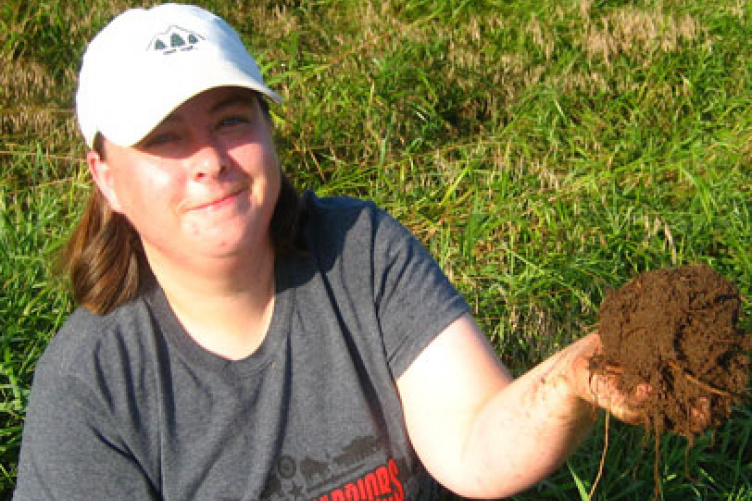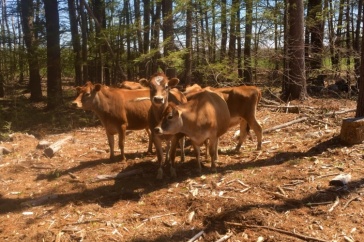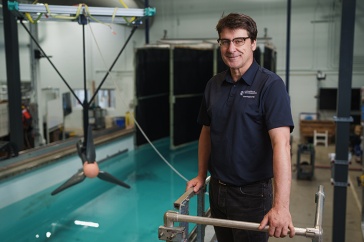
In Uganda, farmers are now cultivating marginal lands, moving uphill on slopes to sow seeds in soil that’s losing its fertility at an alarming rate. This predicament has captured the attention of Lisa Tiemann, a postdoctoral researcher in the College of Life Sciences and Agriculture (COLSA) at the University of New Hampshire (UNH).
Tiemann is a soil microbial ecologist – with a background in ecological and evolutionary biology – who came, specifically, to UNH in order to work under the guidance of assistant professor of soil biogeochemistry Stuart Grandy. “Dr. Grandy, who is doing work on soil organic matter dynamics, has the expertise that I knew would propel me forward in my career,” says Tiemann. “By working in his lab, I am developing skills that I didn’t have when I was pursuing my Ph.D.”
And now, Tiemann has the unique opportunity to expand into and develop core strengths in social geography with the higher goal of bringing a better understanding to the marked soil fertility loss in Uganda. Last summer, this motivated researcher secured a prestigious three-year, $520,299 fellowship through the National Science Foundation’s Science, Engineering, and Education for Sustainability (NFS SEES) program to engage in a comprehensive, multi-disciplinary project with both Grandy and assistant professor of geography Joel Hartter that aims to uncover what’s causing the loss of soil productivity in Uganda. Through the application of practical science, Tiemann expects findings that will help lead efforts to restore crop productivity to this sub-Saharan region.
On the ground studies of soil fertility loss are scarce in Uganda, a country with the eighth highest population growth rate on the planet whose people face certain food insecurity now and into the future. “I’ll be taking the soils information that I’m able to capture doing my soil biogeochemistry work, and putting it in a larger context to make it useful to Ugandan farmers,” says Tiemann. Given the complexity of the situation, she will be taking a mechanistic approach to what’s causing the loss of soil productivity by looking at the detailed characterizations of and processes in the soils, as well as exploring the cultural and socioeconomic dynamics of small holder farmers that have lead to declines in crop yields and soil fertility.
|
Stuart Grandy (left) and Joel Hartter (right) will collaborate with postdoctoral researcher Lisa Tiemann as she embarks on a NSF-funded, multi-disciplinary project that examines enviromental and socioeconomic factors in the loss of soil fertility in Uganda. |
Hartter co-directs the Population, Environment, and Climate in the Albertine Rift project, and has worked in Uganda for the last nine years, where he studies the impacts of population growth and forest loss. Furthermore, Hartter recognizes a need to have greater clarity as to why farmers are making the soil management decisions they do, whether it be a matter of historical precedent, cultural traditions, or simply weighing the risks of soil fertility loss compared with more immediate risks to the health and well-being of their families.
At this time, there is mostly anecdotal evidence for what’s causing the productivity loss of Ugandan soil. The majority of farmers live on less than five acres of land, which are cultivated for two growing seasons with no opportunity to rotate crops. “When the yields grow short, there’s not much protection,” says Hartter, referencing the serious nature of food insecurity for the 33 million people packed into a country the size of the state of Oregon. “On top of that you have poverty, climate change, and agricultural intensification: it’s the perfect storm,” says Hartter. “Lisa has a real opportunity to get involved in local communities and lend her unique skill set to this study on soils.”
During her semiannual month-long trips to Uganda, Tiemann will be collaborating directly with a broad scope of international scientists to develop sophisticated methods for assessing soil fertility and advance her understanding of how microbes and other organisms influence nutrient cycling in soils. Her closest colleagues in Uganda include primatologist Colin Chapman of McGill University stationed at Kibale National Park; Alice Amoding, a soil and water management specialist at the College of Agricultural and Environmental Sciences at Makerere University in Uganda; members of the Kasiisi Project, a non-governmental organization based in Cambridge, MA, that’s involved in reaching out to school children to help them understand the importance of soil fertility through the use of sustainable agricultural practices; and a team of local Ugandans hired to collect data for household surveys that will assist in the initial risk assessment. “Exchanging ideas and scientific expertise with our Ugandan colleagues is vital to the success of this work,” says Grandy.“Together, we will be able to advance our fundamental understanding of soil fertility and apply this new information to improve food security in Uganda.” Back in the States, Tiemann will rely on these new ties between North American and Ugandan researchers as she further analyzes DNA extractions from coolers of shipped soil in order to better understand the interactions of the soil microbial communities with the environment and land use over time.
As one of the world’s foremost biodiversity hotspots along the equator, this part of Uganda experiences a great variability in rainfall throughout a diverse region that encompasses urban centers, rainforest, and agricultural land. Tiemann is sensitive to the complex nature of reversing soil fertility loss, and increasing crop production, within the context of conservation efforts of land reserves in a country that is home to 120 people per square kilometer. “My work up to this point has dealt with the role of microorganisms in determining how carbon and nutrient cycling in soil is influenced by global change,” says Tiemann. Considering such population density and intense needs for food security into the future, she says, “I want to know how these microorganisms are going to function under agricultural intensification as well as with impending climate change.”
“Very little of the information from the national level has made it down to the level of the local farmer,” says Hartter. “And this lack of education, due to a lack of understanding of what’s happening, is driving the choices that farmers are making.” Knowing that more than 80% of children in Uganda will become farmers, Tiemann places great emphasis on the outreach component of this project. She’s taking a documentary film course in order to develop the skills she needs to present her findings in a compelling visual manner that really reaches primary school children and farmers in the area. In addition, she’ll help to develop research test farms around local schools to provide access to hands-on learning in the field. “This is where the rubber meets the road,” says Hartter. “Lisa’s work is so critical and fills such a huge void in the need for practical science.”
Tiemann’s research will provide important information about the fundamental processes that regulate soil fertility everywhere, and her multi-disciplinary approach will bring immediate benefits to crop productivity in Uganda with the adoption of new sustainable agricultural practices. Ultimately, the findings of this project will be essential for food security in Uganda and have a much broader impact on soils around the world.

















































